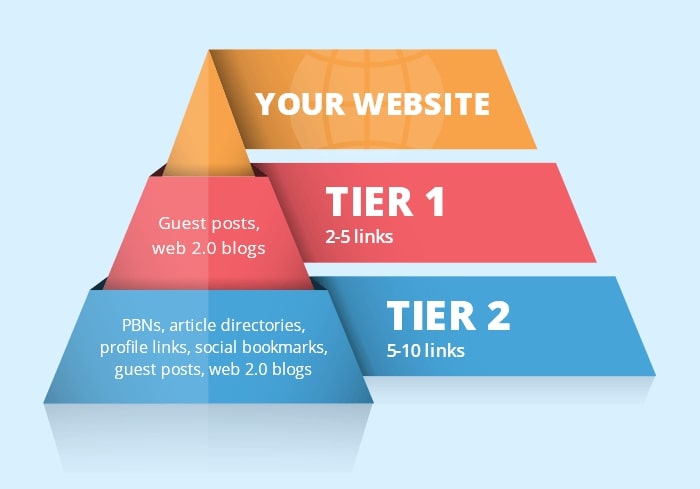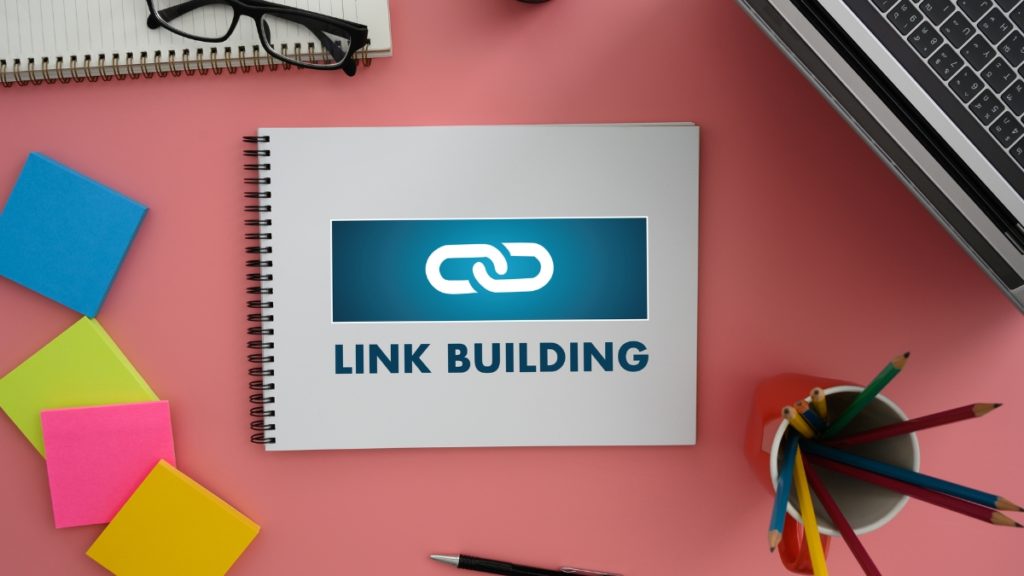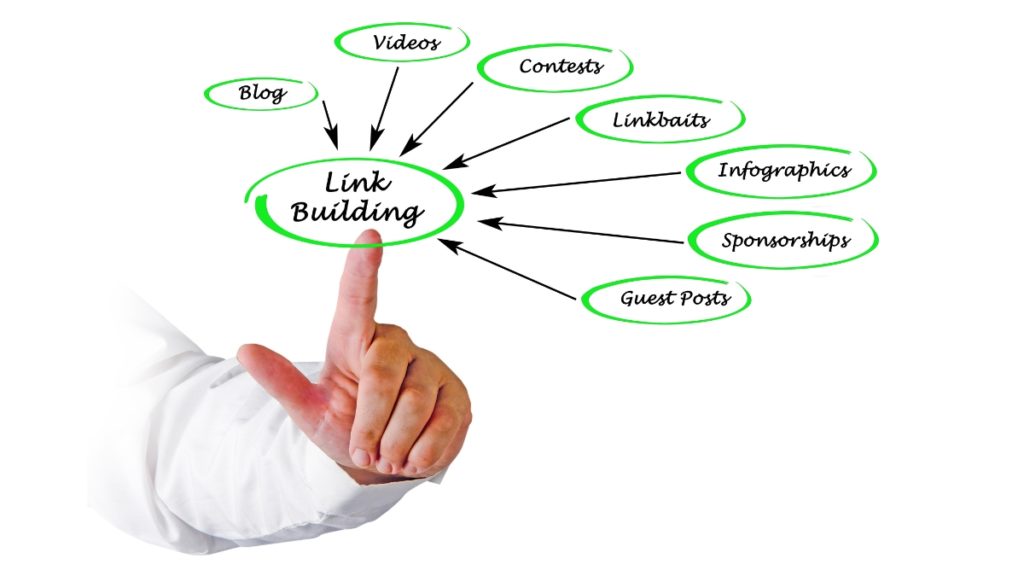Tiered Link Building: All You Need To Know In 2023
In this blog, we’re going to embark on a journey into the realm of tiered link building, exploring its principles, benefits, and best practices. Whether you’re a seasoned SEO pro or just getting started with optimizing your online presence, this guide will equip you with the knowledge you need to make your mark in the digital landscape.
What Is Tiered Link Building?

Tiered link building, also known as link pyramids or link tiers, is a multi-tiered approach to building backlinks to a website. The idea is to create a tiered structure of links, with each tier serving a specific purpose and contributing to the overall SEO effort. The tiers are typically categorized into three levels:
- Tier 1: This is the top tier and the closest to your target website. It consists of high-quality, authoritative backlinks from reputable sources. These are the links you want to direct to your website.
- Tier 2: The second tier supports the first tier. These are links that point to the websites or pages that link to your website (Tier 1). Tier 2 links are generally of slightly lower quality but still valuable.
- Tier 3: This is the lowest tier, which supports the second tier. Tier 3 links point to websites that link to Tier 2. They are usually less authoritative and can be built more quickly and easily.
The idea is that by creating this hierarchical structure of backlinks, you can distribute link authority and SEO benefits more effectively to your target website. This method helps in avoiding over-optimization, which could lead to penalties from search engines.
What Are The Benefits Of Tiered Link Building?
Now that you understand the basic concept of tiered link building, let’s explore some of the benefits it offers to your SEO strategy:
Improved Rankings
Tiered link building can significantly boost your website’s rankings in search engine results pages (SERPs). The quality and diversity of links from Tier 1, Tier 2, and Tier 3 can enhance your website’s authority.
Natural Link Profile
By creating a multi-tiered structure, you mimic a more natural link profile. Search engines tend to favor websites with diverse and organic backlink profiles, and tiered link building helps achieve this.
Controlled Risk
With tiered link building, you have more control over your SEO efforts. If any of your lower-tier links attract penalties or become less effective, you can adjust or remove them without impacting your Tier 1 links.
Enhanced Authority
As your website gains authority through Tier 1 links, it becomes easier to attract high-quality backlinks naturally, further strengthening your online presence.
Does Tiered Link Building Come With Risks?

Yes, tiered link building, like many SEO strategies, does come with certain risks and potential drawbacks that website owners and digital marketers should be aware of.
While tiered link building can be an effective way to improve your website’s SEO and rankings, it’s important to understand and mitigate these risks to avoid potential negative consequences. Here are some of the risks associated with tiered link building:
Penalties from Search Engines
If search engines detect that you are engaging in manipulative or black-hat SEO practices, such as creating a network of low-quality or irrelevant links, you could face penalties that result in a drop in rankings or even deindexing from search results.
Algorithmic Changes
A strategy that relies heavily on tiered link building may become less effective or even obsolete if search engines change their algorithms. It’s crucial to stay updated with SEO best practices and adapt your strategy accordingly.
Time and Resource Investment
Building and maintaining multiple tiers of backlinks require careful planning, outreach, and monitoring. The resources spent on tiered link building could potentially be allocated to other SEO strategies that yield better results for your specific goals.
Quality Control
if the lower-tier links deteriorate in quality or attract penalties, they can negatively impact the authority of your Tier 1 links and, subsequently, your website’s SEO. Regular monitoring and maintenance are necessary to address this risk.
Link Profile Unnaturalness
If not executed correctly, tiered link building can make your website’s link profile appear unnatural to search engines. To mitigate this risk, ensure that your link profile is diverse and includes a mix of link types, anchor text, and sources.
Dependency on External Websites
Tiered link building relies on external websites linking to your site. If any of these external websites experience issues, such as downtime, removal of content, or changes in their linking strategy, it can affect the effectiveness of your tiered link building efforts.
When You Should Do Tiered Link Building?
Tiered link building can be a useful SEO strategy in certain situations, but it’s important to recognize when it’s appropriate to implement this approach. Here are some scenarios in which tiered link building may be a suitable strategy:
Establishing a New Website
If you’ve just launched a new website and want to improve its visibility and rankings quickly, tiered link building can help. It allows you to build a strong foundation of backlinks and authority.
Competitive Niches
In highly competitive niches or industries where many websites are vying for top search engine rankings, tiered link building can give you an edge. It helps you build a robust and diverse backlink profile that can compete with other authoritative websites.
Recovering from a Ranking Drop
If your website has experienced a drop in rankings due to algorithm updates or penalties, tiered link building can be part of a strategy to recover your lost visibility.
Targeting Specific Keywords
When you have specific keywords or phrases that you want to rank for, tiered link building can be used strategically to boost your rankings for those keywords. By creating a tiered structure with relevant anchor text, you can optimize your link profile for specific search terms.
Enhancing Authority for Content Marketing
If you have a content marketing strategy in place and want to ensure that your content gets the visibility it deserves, tiered link building can help improve the authority of your blog posts, articles, or other content assets. This can result in better organic traffic and engagement.
Building Relationships with Influencers
Tiered link building can be a part of your outreach strategy to build relationships with influencers or authoritative websites in your industry. By offering valuable content and collaboration opportunities, you can earn high-quality backlinks from them.
Diversifying Your SEO Strategy
It’s often recommended to have a diversified SEO strategy that includes various tactics, such as on-page optimization, content marketing, technical SEO, and link building. Tiered link building can be one element of this diversified approach.
It’s important to note that while tiered link building can be effective in these scenarios, it should always be conducted with integrity and a focus on high-quality, relevant backlinks.
Before implementing tiered link building, consider conducting a thorough SEO audit, researching your competition, and creating a well-thought-out strategy. Additionally, stay informed about the latest SEO trends and best practices to ensure that your approach aligns with current guidelines and algorithms.
What Are Tiered Link Building Common Practices?
1. Quality over Quantity: Focus on acquiring high-quality backlinks for your Tier 1. Research and outreach to authoritative websites in your niche.
2. Relevance Matters: Ensure that the websites linking to your site are relevant to your industry or niche. Relevance plays a significant role in SEO.
3. Anchor Text Variation: Use diverse anchor text for your backlinks to make your link profile appear more natural.
4. Monitor and Maintain: Regularly assess the performance of your tiered link building strategy. Disavow toxic backlinks, update content, and adjust your approach as needed.
5. Avoid Automation: While some tools can help with tiered link building, avoid fully automated processes. Personalized outreach and engagement tend to yield better results.
Black Hat Tiered Link Building
Black hat tiered link building is not recommended and can have serious consequences for your website’s search engine rankings and overall online reputation. This tactic involve manipulative and unethical strategies to artificially boost a website’s rankings, and they violate search engine guidelines.
Link Farms
Building or participating in link farms, which are networks of websites that exist solely for the purpose of exchanging links, is a black hat practice. These links are often of low quality and offer little to no value to users.
Automated Link Building Software
Using automated software to create and distribute links across the web in an unnatural and spammy manner is considered black hat. These tools often generate low-quality links on irrelevant websites.
Private Blog Networks (PBNs)
PBNs are a black hat tactic where individuals or companies create a network of their own websites solely for the purpose of linking to their main website. These networks are typically hidden from search engines and used to manipulate rankings.
Keyword Stuffing and Over-Optimization
Overusing keywords in anchor text, content, or meta tags with the intention of ranking higher is a black hat practice. This can lead to keyword stuffing penalties from search engines.
Paid Links
Purchasing links from websites or individuals with the intention of manipulating rankings is against search engine guidelines. Search engines like Google can detect paid links and may penalize websites involved in this practice.
Spammy Guest Posting
Guest posting for the sole purpose of inserting low-quality, irrelevant links in the content is considered black hat. This is different from legitimate guest posting, which provides valuable content to readers.
Engaging in black hat tiered link building can lead to severe consequences, including:
- Penalties: Search engines can penalize your website by dropping its rankings or even removing it from search results altogether.
- Loss of Trust: Black hat tactics can damage your website’s reputation, making it less trustworthy to both search engines and users.
- Long-Term Harm: Recovering from penalties and rebuilding your website’s reputation can be a lengthy and challenging process.
Instead of resorting to black hat techniques, it’s advisable to focus on ethical and sustainable SEO practices known as Whitehat building. This includes creating high-quality, relevant content, building natural and valuable backlinks, optimizing your website for user experience, and staying within the guidelines set by search engines.
White Hat Tiered Link Building

White hat tiered link building, when done correctly, involves creating a structured network of high-quality, relevant backlinks to improve a website’s search engine rankings and authority while adhering to ethical SEO practices and search engine guidelines. This technique focuses on providing value to users and building a strong, organic link profile.
Tier 1 Links (Highest Quality)
The first tier consists of high-quality, authoritative backlinks that point directly to your website. These are links from reputable sources and websites in your niche or industry. They are typically acquired through outreach, content partnerships, or by creating exceptional content that naturally attracts links.
Tier 2 Links (Supporting Tier 1)
The second tier comprises links that point to the websites or pages in Tier 1. These links are used to enhance the authority and value of Tier 1 links. They should also be of high quality and relevance.
Tier 3 Links (Supporting Tier 2)
The third tier links to websites or pages in Tier 2, indirectly supporting the Tier 1 links. Tier 3 links can be somewhat less authoritative but should still maintain relevance to your niche.
Best Practices for White Hat Tiered Link Building
Relevance Is Key
Ensure that all links, regardless of tier, are relevant to your website’s niche or industry. Relevance helps maintain the integrity of your link profile and improves SEO.
Quality Over Quantity
Prioritize quality links over a large number of links. A few high-quality links from authoritative sources can have a more significant impact than many low-quality links.
Natural Anchor Tex
Use natural and varied anchor text for your backlinks. Avoid keyword stuffing or over-optimized anchor text, which can appear unnatural to search engines.
Diverse Sources
Diversify the sources of your backlinks. Seek links from various types of websites, such as blogs, news sites, forums, and social media, to create a balanced link profile.
Outreach and Relationship Building
Engage in outreach to build relationships with influencers, bloggers, and authoritative websites in your industry. Building these connections can lead to valuable Tier 1 links.
Content Quality
Create high-quality content that is informative, engaging, and valuable to your target audience. Great content naturally attracts backlinks.
Ongoing Monitoring
Regularly monitor the performance of your tiered link building strategy. Address any issues with lower-tier links that may negatively impact your Tier 1 links.
Transparency and Honesty
Be transparent and ethical in your link building practices. Avoid any tactics that could be seen as manipulative or deceptive.
Remember that white hat tiered link building is a long-term strategy that requires patience and consistency. It’s essential to stay up-to-date with SEO best practices and search engine guidelines to ensure your strategy remains effective and compliant.
Tiered Link Building: Final Thoughts
In conclusion, tiered link building can be a powerful tool in your SEO arsenal, but it’s not a one-size-fits-all solution. It requires careful planning, ethical practices, and ongoing monitoring to ensure success. As you implement this strategy, remember that SEO is an ever-evolving field, so staying updated with industry trends and adapting your approach is key to long-term success.
As you embark on your SEO journey, keep exploring, experimenting, and refining your strategies to achieve your website’s goals and reach new heights in the digital landscape. If you need help with SEO optimization, let’s install SearchPie – one of the top-rated Shopify SEO apps, and we will assist you in achieving that.
Author Bio

Krystal is an experienced SEO consultant in SearchPie with hands-on experience in optimizing websites for search engines and driving organic traffic. With a passion for digital marketing and a track record of delivering measurable results, Krystal has helped numerous businesses of all sizes achieve higher Online SEO performance, increased online visibility, and improved conversion rates.
Krystal is also known for her data-driven approach to SEO, using advanced analytics tools to assess website performance, identify opportunities for improvement, and implement strategies that drive sustainable growth.
With a strong commitment to transparency and client education, Krystal empowers businesses to understand the intricacies of SEO and its impact on their online presence. She enjoys breaking down complex SEO concepts into understandable, actionable steps, enabling clients to make informed decisions about their digital marketing strategies.
Connect with Krystal and her team via Search Pie to receive free SEO consultation and tips to grow your business.
Contact:
Email: thuyduong.nguyen@secomus.com





